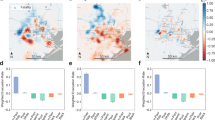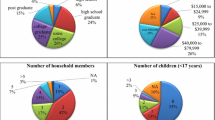Abstract
This paper contributes to the growing body of social science research on population displacement from disasters by examining the social determinants of evacuation behavior. It seeks to clarify the effects of race and socioeconomic status on evacuation outcomes vis-a-vis previous research on Hurricane Katrina, and it expands upon prior research on evacuation behavior more generally by differentiating non-evacuees according to their reasons for staying. This research draws upon the Harvard Medical School Hurricane Katrina Community Advisory Group’s 2006 survey of individuals affected by Hurricane Katrina. Using these data, we develop two series of logistic regression models. The first set of models predicts the odds that respondents evacuated prior to the storm, relative to delayed- or non-evacuation; the second group of models predicts the odds that non-evacuees were unable to evacuate relative to having chosen to stay. We find that black and low-education respondents were least likely to evacuate prior to the storm and among non-evacuees, most likely to have been unable to evacuate. Respondents’ social networks, information attainment, and geographic location also affected evacuation behavior. We discuss these findings and outline directions for future research.
Similar content being viewed by others
Notes
As justified later in the paper and in footnote #10, we use a measure of education as an indicator of household socioeconomic status. We refer to “education effects” when discussing the particular findings of our statistical models, but refer to “socioeconomic status” when discussing the conceptualization of our research question and referring to previous literature on evacuation behavior, which has utilized multiple indicators of socioeconomic status.
An extensive review by Dash and Gladwin (2007) demonstrates that previous research on this topic has examined the effect of numerous other characteristics of evacuees and non-evacuees (e.g., gender), as well as the psychosocial dimensions of the evacuation process.
Gallup Poll #2005-45.
Household evacuation strategies were categorized according to (a) the timing of evacuation and (b) whether or not household members remained united or divided.
Both Elliott and Pais (2006) and Haney et al. (2007) report a number of other statistically significant factors in their models. Elliot and Pais find significant gender differences in some comparisons. Haney et al. observe significant differences in evacuation strategies according to employment, religion, and sex. Because they do not interact with or otherwise affect their findings regarding race and socioeconomic status, we exclude this from our discussion for the sake of brevity.
“Affected areas” are defined as those counties and parishes that were declared eligible for “individual assistance” by FEMA.
Adjustments were made for overlap in the sampling frames (see Hurricane Katrina Community Advisory Group 2006 for details).
To easily interpret odds ratios <1.000, one should invert the coefficient \(\left( {\frac{1}{\beta }} \right)\). The quotient expresses the degree to which respondents in group k of variable x i were less likely to experience outcome Y 1 than those in the reference group, in the same terms as coefficients above 1.000.
Although an income variable was also available, we found that education and income were significantly and strongly correlated (r = 0.417). We chose to use education and exclude the income variable for two primary reasons. First, the income variable reports household income, which is not appropriate given that our outcome and all other explanatory variables are individual-level indicators. Second, income is more prone to reporting bias than education.
We consider responses of 0–4 to either of the following questions “low” and responses of 5+ “high”: (1) “about how many friends or relatives in the county/parish were you close enough to that you could talk about your private feelings without feeling embarrassed?”; and (2) “about how many friends or relatives who did not live in the country/parish were you close enough to that you could talk about your private feelings without feeling embarrassed?” The median responses to these questions were 5.0 and 4.0, respectively, therefore 4.0 provides a reasonable central point around which to assign respondents to these categories.
Although some respondents’ social network classification may reflect socially insignificant county/parish boundary lines, we have no reason to believe that the distribution of such boundary effects is non-random across the four social network categories or any other variable in our statistical models.
We also consider the possibility that information attainment reflects the respondent’s connection to (isolation from) mainstream society.
This variable consists of three categories: we consider 0–4 recommendations “low” information attainment, 5–15 “medium”, and 16 or greater “high.” These thresholds distribute respondents as evenly as possible across the three categories.
This includes systematic reporting biases.
Due to confidentiality restrictions, we were unable to obtain respondents’ zip codes of residence from the Harvard study to link community- and individual-level data. We would have liked, for example, to examine whether living in neighborhoods with high poverty or nativity rates affected the odds that an individual evacuated and the reason for not evacuating.
References
Barnshaw, J., & Trainor, J. (2007). Race, class, and capital amidst the Hurricane Katrina diaspora. In D. L. Brunsma, D. Overfelt, & J. S. Picou (Eds.), The sociology of Katrina: Perspectives on a modern catastrophe (pp. 91–105). New York: Rowman and Littlefield.
Campanella, R. (2008). Bienville’s dilemma: A historical geography of new orleans. Lafayette: Center for Louisiana Studies.
Cutter, S. L., Boruff, B. J., & Lynn Shirley, W. (2003). Social vulnerability to environmental hazards. Social Science Quarterly, 84(2), 242–261.
Dash, N., & Gladwin, H. (2007). Evacuation decision making and behavioral responses: Individual and household. Natural Hazards Review, 8(3), 69–77.
Dyson, M. E. (2006). Come hell or high water: Hurricane Katrina and the color of disaster. New York: Basic Books.
Elliott, J. R., & Pais, J. (2006). Race, class, and Hurricane Katrina: Social differences in human responses to disaster. Social Science Research, 35(2), 295–321.
Falk, W. W. (2004). Rooted in place: Family and belonging in a southern black community. New Brunswick: Rutgers University Press.
Falk, W. W., Hunt, M. O., & Hunt, L. L. (2006). Hurricane Katrina and New Orleanians’ sense of place: Return and reconstitution or ‘gone with the wind’? Du Bois Review, 3(1), 115–128.
Finch, C., Emrich, C. T., & Cutter, S. L. (2010). Disaster disparities and differential recovery in New Orleans. Population and Environment, 31(4), 179–202.
Fothergill, A., Maestas, Enrique G. M., & Darlington, J. D. (1999). Race, ethnicity, and disaster in the United States: A review of the literature. Disasters, 23(2), 156–173.
Fothergill, A., & Peek, L. A. (2004). Poverty and disasters in the United States: A review of recent sociological findings. Natural Hazards, 32(1), 89–110.
Fussell, E. (2005). Leaving New Orleans: Social stratification, networks, and hurricane evacuation. Understanding Katrina, Social Science Research Council. http://understandingkatrina.ssrc.org/fussell. Accessed 30 Dec 2012.
Gladwin, H., & Peacock, W. G. (1997). Warning and evacuation: A night for hard houses. In W. G. Peacock, B. H. Morrow, & H. Gladwin (Eds.), Hurricane Andrew: Ethnicity, gender, and the sociology of disasters (pp. 52–74). New York: Routledge.
Groen, J. A., & Polivka, A. E. (2008). The effect of Hurricane Katrina of the labor market outcomes of evacuees. The American Economic Review, 98(2), 43–48.
Groen, J. A., & Polivka, A. E. (2010). Going home after Hurricane Katrina: Determinants of return migration and changes in affected areas. Demography, 47(4), 821–844.
Haney, T. J., Elliot, J. R., & Fussell, E. (2007). Families and Hurricane response: Evacuation, separation, and the emotional toll of Hurricane Katrina. In D. L. Brunsma, D. Overfelt, & J. S. Picou (Eds.), The Sociology of Katrina: Perspectives on a Modern Catastrophe (pp. 71–90). New York: Rowman and Littlefield.
Hori, M., & Shafer, M. J. (2010). Social costs of displacement in Louisiana after Hurricanes Katrina and Rita. Population and Environment, 31(1–3), 64–86.
Hosmer, D. W., & Lemeshow, S. (1989). Applied logistic regression. New York: Wiley.
Hunter, L. (2005). Migration and environmental hazards. Population and Environment, 26(4), 273–302.
Hurricane Katrina Community Advisory Group. (2006). Overview of Baseline Survey Results: Hurricane Katrina Community Advisory Group. www.hurricanekatrina.med.harvard.edu. Accessed 30 Dec 2012.
Kessler, R. C. (2009). Hurricane Katrina community advisory group study [United States]. Ann Arbor: Inter-University Consortium for Political and Social Research.
Knabb, R. D., Rhome, J. R., & Brown, D. P. (2005). Tropical cyclone report: Hurricane Katrina. Washington: NOAA.
Logan, J. (2012). Making a place for space: Spatial thinking in social science. Annual Review of Sociology, 38(1), 507–524.
Massey, D. (1990). Social structure, household strategies, and the cumulative causation of migration. Population Index, 56(1), 3–26.
Mileti, D. S. (2001). Disasters by design: A reassessment of natural hazards in the United States. Washington: Joseph Henry.
Morrow, B. H. (1997). Stretching the bonds: the families of Andrew. In W. G. Peacock, B. H. Morrow, & H. Gladwin (Eds.), Hurricane Andrew: Ethnicity, gender, and the sociology of disasters (pp. 141–170). New York: Routledge.
Morrow, B. H. (1999). Identifying and mapping community vulnerability. Disasters, 23(1), 1–18.
Myers, C. A., Slack, T., & Singelmann, J. (2008). Social vulnerability and migration in the wake of disaster: The case of Hurricane Katrina and Rita. Population and Environment, 29(6), 271–291.
Picou, J. S., & Marshall, B. K. (2007). Katrina as a paradigm shift: Reflections on disaster research in the twenty-first century. In D. L. Brunsma, D. Overfelt, & J. S. Picou (Eds.), The Sociology of Katrina: Perspectives on a modern catastrophe (pp. 1–20). New York: Rowman and Littlefield.
Smith, S. K., & McCarty, C. (2009). Fleeing the storm(s): An examination of evacuation behavior during Florida’s 2004 Hurricane season. Demography, 46(1), 127–145.
Stark, O., & Bloom, D. E. (1985). The new economics of labor migration. The American Economic Review, 72(2), 173–178.
Stein, R. M., Dueñas-Osorio, L., & Subramanian, D. (2010). Who evacuates when hurricanes approach? The role of risk, information, and location. Social Science Quarterly, 91(3), 816–834.
Stringfield, J. D. (2010). Higher ground: An exploratory analysis of characteristics affecting returning populations after Hurricane Katrina. Population and Environment, 31(1–3), 43–63.
Wisner, B., Blaikie, P., Cannon, T., & Davis, I. (Eds.). (2004). At risk: Natural hazards, people’s vulnerability, and disasters (2nd ed.). New York: Routledge.
Zhang, Y., Prater, C. S., & Lindell, M. K. (2004). Risk area accuracy and evacuation from Hurricane Bret. Natural Hazards Review, 5(3), 115–120.
Zottarelli, L. K. (2008). Post-Hurricane Katrina employment and recovery: The interaction of race and place. Social Science Quarterly, 89(3), 592–607.
Acknowledgments
This article benefitted greatly from the insights of Max Pfeffer, Scott Sanders, Laura Hathaway, and anonymous reviewers. The authors alone are responsible for mistakes of any kind. This research was supported by the Cornell Population Center, Cornell Population and Development Program, and USDA multi-state research project W-2001 “Population Dynamics and Change: Aging, Ethnicity and Land Use Change in Rural Communities,” administered by the Cornell University Agricultural Experiment Station project 159-6808.
Author information
Authors and Affiliations
Corresponding author
Rights and permissions
About this article
Cite this article
Thiede, B.C., Brown, D.L. Hurricane Katrina: Who Stayed and Why?. Popul Res Policy Rev 32, 803–824 (2013). https://doi.org/10.1007/s11113-013-9302-9
Received:
Accepted:
Published:
Issue Date:
DOI: https://doi.org/10.1007/s11113-013-9302-9




